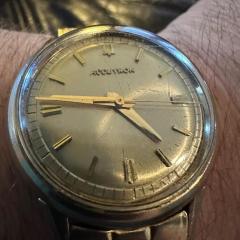Hamilton Electric - gets power, sets time, hands don’t tick
-
Recently Browsing
- No registered users viewing this page.
-
Topics
-
Posts
-
You need to bring the pad to the dial, that way you've got more control on how much pressure you apply.
-
By nevenbekriev · Posted
Sorry I have this thread forgotten. Now, why the stones break? Several reasons: One - the old stones are crunchy. Be careful! Two - wrong tweezers. Use brass ones. Three - wrong approach. The best way is not to grasp the stone close to working side. Grasp it for the middle part, the tweezers direction to be perpendicular to the stone. Use oscillating tilting movements when moving the stone. Now several tips that are not read from the books, but found in my practice. They are good for my way of correcting pallet stones position: You don't need the heater for adjusting the stones position. The heater will be needed only to glue/fix the stone when the adjustment is already done. The stone should seat tight enough in the slot without gluing. Tight enough so the movement will work normally and thus checking if the adjustment is correct is to be done before gluing. If the stone is loose in the slot, then heating and melting the shellac will make the stone move in by the capillary force. So, if the stone is loose in the slot, then find out if the stone is not correct or the slot is opened. If the slot is opened, then (in steel pallet forks) it is good idea to anneal locally only the small part that forms the slot before trying to close the slot. Also, put in the slot something slightly thinner than the pallet to limit the amount of bending If the stone must go out, the shellac can stay in place, it will not make the adjustment harder. Just bend the stone to break the bond between the shellac and stone. Then heating only will glue the stone again if the shellac is not old and degraded. If the stone must go in, then the shellac mus be removed from the slot bottom as to make space for the stone to go in. I often use pallet stones from USSR Slava alarm clock for pocket watches repair. Slava pallet stones are usually bigger (wider) than needed) and I grind/lap them to correct size for the slot. Grinding is of the side that never contacts the EW teeth. It is enough to put the stone on the lapping plate, pres on it with finger and move it forward/reverse several times while pressing, then check in the slot. -
I used a small ultrasonic for years until it died, but it does need to be large enough to fit jars in to hold your parts, and small parts ideally are in mesh baskets within the jars so you are not fishing them out one by one with tweezers. So the one you linked might be too small and this kind of thing really the minimum workable size
-
You'll probably find when you get the dial it's slightly under the stated size to start with. Depending on the dial I'd mount it on a mandrel then spin it in a drill using a hard sanding pad to reduce the diameter.
-





.thumb.jpg.19a9c4ff164d78d516aa9f05a063752b.jpg)

Recommended Posts
Join the conversation
You can post now and register later. If you have an account, sign in now to post with your account.
Note: Your post will require moderator approval before it will be visible.